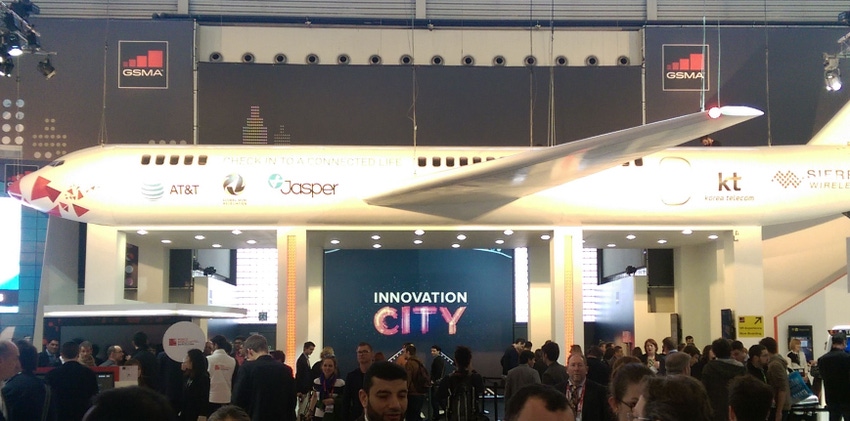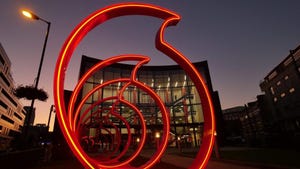It was no surprise to hear the terms 5G, IoT and cloud used relentlessly in conversations and press releases at Mobile World Congress 2016, but unlike last year there was more to them than mere marketing opportunism.
February 27, 2016

It was no surprise to hear the terms 5G, IoT and cloud used relentlessly in conversations and press releases at Mobile World Congress 2016, but unlike last year there was more to them than mere marketing opportunism.
The default conversational gambit to kick off a meeting at MWC is something along the lines of “so what are you hearing from the show floor?” The equally inevitable answer usually consists of a montage of buzzwords interspersed with reassuringly corporate terms like ‘traction’, ‘leverage’ and ‘ramping’. Then everyone walks away satisfied that they ticked the right boxes but somewhat concerned that they didn’t really know what they just said.
That was very much the template at MWC 2015, where there was total consensus that the major themes of the show were 5G, IoT and cloud. Nobody really knew what the hell those terms actually meant in a tangible, substantial, useful sense, but everyone was prepared to stake their professional reputation on the certainty that they were going to be BIG.
Fast forward a year and the same buzzwords abounded, but instead of being delivered in the loud, theatrical style of the over-compensating bluffer they were served up in calm, measured tones which were then, amazingly, substantiated with real facts, case studies and evidence of actual commercial activity.
5G is going to be the gift that keeps on giving to us telecoms hacks for at least the next five years. The eventual standard itself is expected around 2020 but the industry is already in a frenzy of trialling, partnering and general jostling for position. This year, while we didn’t know much more about the technical details of the next wireless standard there were more detailed conversations about what 5G needs to be.
On one hand it needs to be one more than 4G – i.e. an order of magnitude higher performing. This will require lots of cleverness involving a bewilderingly wide range of technologies. The utopia we imagine is bandwidth so large and robust that we stop even talking about speeds and feeds, and just take it for granted that we can stream 8K video wherever and whenever we want. Parents will recount horror stories to their wide-eyed children of buffering, haltering streams and that little swirly thing that seems to mock you when you’re trying to watch the latest Game of Thrones on your iPad.
But on the other hand it needs to be ubiquitous and low power in order to support IoT, on which more shortly. Most probable IoT use-cases will require minimal data rates but will need to always be connected, use virtually no power and be 100% reliable. These are two very different aims and imply two parallel streams of 5G development, which will be greatly assisted by the clarity of thinking on the matter demonstrated at the show.
IoT is now, mercifully, far removed from talk of smart appliances making decisions and running your life for you to an Orwellian extent. Companies like Jasper, Tecnotree and Synchronoss are talking about engaging directly with brands from a wide array of industries to help them offer their customer innovative and genuinely useful connected services.
The job of most companies in the telecoms food chain is to do the boring, behind the scenes stuff so their customers – traditionally operators – can served up cool new products to the market. IoT opens up the possibility for a new breed of IT services company to go directly to a brand and enable them to create connected services for their market. People might be more comfortable buying a a smart home package from Ikea, or British Gas or Black and Decker then they would from an operator. This in turn means that operators need to raise their game further and acknowledge that they’re not just going to be competing with each other for business in future.
Just as 5G and IoT are already interdependent, so they both are on the third of our buzzword trinity: the cloud. A persistent theme at the show was that the cloud conversation has moved from ‘if’ to ‘when’ and ‘how’. Much of last year’s caution and mistrust has evaporated and the arguments in favour of virtualisation – agility, speed, efficiency – have been won.
Telecoms is an industry that has been guilty of inertia, conservatism and outright denial in the past, with challenges often only fully confronted when it was almost too late to do anything about them. One of the reasons ‘OTTs’ have provided such an enduring challenge for telcos is their ability to launch new products rapidly and ‘fail fast’. You can never be sure a new product will be a success but the easier you make it to launch one, the less business risk accompanies it. Telcos seem to fully understand that virtualization has the potential to perform that function and seem ready to embrace it fully.
The vibe on the show floor was generally pretty positive this year. There was less hand-wringing about the perennial ‘dumb pipe’ fear and more discussion about exactly how to overcome it. Talk of ARPU has given way to talk of new markets. The tone was less defensive and more innovative, with the acknowledgment that we live in interesting times so we might as well embrace it. A lot of questions remain unanswered, including why it’s so difficult to get a decent sandwich in the Fira, but there was a sense of excitement at the opportunities they will eventually create and a general willingness to look facts in the face that was good to see.
Read more about:
DiscussionAbout the Author(s)
You May Also Like








.png?width=300&auto=webp&quality=80&disable=upscale)


_1.jpg?width=300&auto=webp&quality=80&disable=upscale)


.png?width=800&auto=webp&quality=80&disable=upscale)